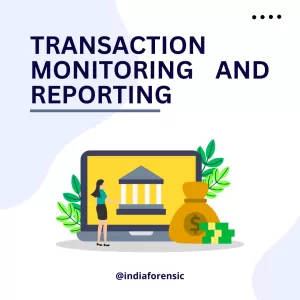In the complex world of rules, transaction reporting and monitoring are super important. They make sure things are clear and safe, and follow the rules in banks and financial institutions. As things change in money systems, the ways we watch and tell about transactions also change. There are two primary aspects of suspicious transactions first is identification and second is reporting. Transactions are identified during the transaction monitoring process.
Transaction Monitoring
Keeping an eye on financial transactions in real-time is crucial to prevent risks, fraud, and bad activities. It’s like having a guardian for your money. This process helps make sure that the financial system stays honest and follows the rules set by the authorities. So, whenever you buy or move money, someone is watching to make sure everything is safe and sound. It’s an important part of making sure your money and the entire financial system stay on the right track.
- Function: Watching your money closely! Banks and financial institutions keep a constant eye on your transactions—like when you deposit, withdraw, or transfer money. Why? They’re on the lookout for anything fishy that might indicate red flags of money laundering, funding terrorism, fraud, or other illegal activities. It’s their way of making sure everything’s above board and keeping your money safe.
- Methods: Utilizes various techniques like rule-based scenarios, anomaly detection algorithms, and machine learning models, to identify transactions deviating from established patterns or known risk profiles.
- Tools: Dedicated software solutions often employ AI and advanced analytics to automate monitoring and flag potentially suspicious transactions for further investigation.
- Importance: Early detection of suspicious activity allows for timely intervention and prevention of financial crime, protecting both financial institutions and their customers.
Transaction Reporting
Transaction reporting is like keeping a record of all the money activities that happen in a certain period, like a month or a year. This happens in places like banks and other financial services. The reason we do this is to follow the rules set by the government or other authorities. These rules make sure that banks and financial places are doing things the right way, keeping the money system honest and fair for everyone. So, transaction reporting is a way of showing that these places are playing by the rules and keeping everything in order.
- Function: When a transaction seems fishy and investigators look into it, they write a report about it. This report is then sent to the right authorities. People often call these reports “Suspicious Activity Reports” or SARs for short. It’s like telling the financial cops about transactions that seem a bit off, so they can check it out and keep things safe.
- Requirements: Regulated entities like banks, insurance companies, and brokers are mandated to report suspicious transactions under Anti-Money Laundering (AML) and Counter-Terrorist Financing (CFT) regulations.
- Content: Reports typically detail the suspected activity, involved parties, and supporting evidence gathered during the investigation.
- Impact: Reporting assists law enforcement agencies in investigating potential financial crimes and prosecuting perpetrators.
Relationship between the Transaction Monitoring and Reporting
Transaction monitoring and reporting are intertwined in meeting regulatory requirements. Financial institutions must adhere to specific regulations and guidelines set by authorities to combat financial crimes. Transaction monitoring identifies potential risks, and reporting ensures that these risks are communicated to the relevant regulatory bodies.
Transaction monitoring acts as the frontline defense, identifying and assessing risks in real time. Reporting becomes the mechanism through which identified risks are escalated, documented, and communicated to regulatory entities. This collaboration is fundamental to effective risk mitigation strategies.
- Monitoring identifies: Transaction monitoring acts as the first line of defense. It sifts through large volumes of transactions and identifies those requiring further scrutiny.
- Reporting facilitates action: Transaction reporting escalates suspicious activity to appropriate authorities and provides crucial information for investigations and potential prosecutions.
Effective transaction monitoring and reporting programs take into account an entity’s specific risk profile. Later it tailors their rules and procedures accordingly. Protecting sensitive customer and transaction data is essential throughout the monitoring and reporting process. While technology plays a significant role, Certified Transaction Monitoring Experts are ultimately responsible for investigating flagged transactions and determining the need for reporting.


